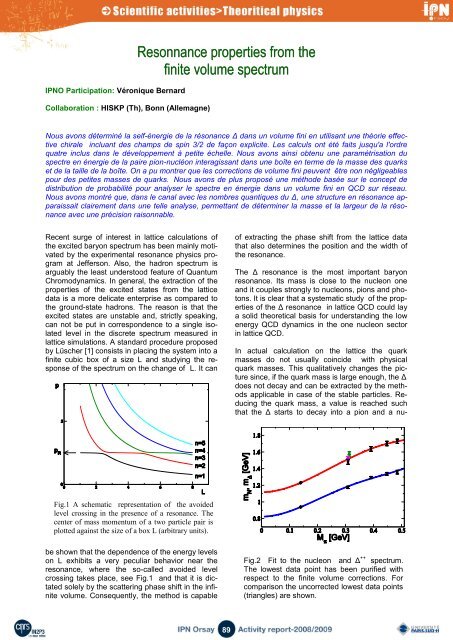exotic nuclei structure and reaction noyaux exotiques ... - IPN - IN2P3
exotic nuclei structure and reaction noyaux exotiques ... - IPN - IN2P3
exotic nuclei structure and reaction noyaux exotiques ... - IPN - IN2P3
You also want an ePaper? Increase the reach of your titles
YUMPU automatically turns print PDFs into web optimized ePapers that Google loves.
<strong>IPN</strong>O Participation: Véronique Bernard<br />
Collaboration : HISKP (Th), Bonn (Allemagne)<br />
Resonnance properties from the<br />
finite volume spectrum<br />
Nous avons déterminé la self-énergie de la résonance Δ dans un volume fini en utilisant une théorie effective<br />
chirale incluant des champs de spin 3/2 de façon explicite. Les calculs ont été faits jusqu'a l'ordre<br />
quatre inclus dans le développement à petite échelle. Nous avons ainsi obtenu une paramétrisation du<br />
spectre en énergie de la paire pion-nucléon interagissant dans une boîte en terme de la masse des quarks<br />
et de la taille de la boîte. On a pu montrer que les corrections de volume fini peuvent être non négligeables<br />
pour des petites masses de quarks. Nous avons de plus proposé une méthode basée sur le concept de<br />
distribution de probabilité pour analyser le spectre en énergie dans un volume fini en QCD sur réseau.<br />
Nous avons montré que, dans le canal avec les nombres quantiques du Δ, une <strong>structure</strong> en résonance apparaissait<br />
clairement dans une telle analyse, permettant de déterminer la masse et la largeur de la résonance<br />
avec une précision raisonnable.<br />
Recent surge of interest in lattice calculations of<br />
the excited baryon spectrum has been mainly motivated<br />
by the experimental resonance physics program<br />
at Jefferson. Also, the hadron spectrum is<br />
arguably the least understood feature of Quantum<br />
Chromodynamics. In general, the extraction of the<br />
properties of the excited states from the lattice<br />
data is a more delicate enterprise as compared to<br />
the ground-state hadrons. The reason is that the<br />
excited states are unstable <strong>and</strong>, strictly speaking,<br />
can not be put in correspondence to a single isolated<br />
level in the discrete spectrum measured in<br />
lattice simulations. A st<strong>and</strong>ard procedure proposed<br />
by Lüscher [1] consists in placing the system into a<br />
finite cubic box of a size L <strong>and</strong> studying the response<br />
of the spectrum on the change of L. It can<br />
of extracting the phase shift from the lattice data<br />
that also determines the position <strong>and</strong> the width of<br />
the resonance.<br />
The Δ resonance is the most important baryon<br />
resonance. Its mass is close to the nucleon one<br />
<strong>and</strong> it couples strongly to nucleons, pions <strong>and</strong> photons.<br />
It is clear that a systematic study of the properties<br />
of the Δ resonance in lattice QCD could lay<br />
a solid theoretical basis for underst<strong>and</strong>ing the low<br />
energy QCD dynamics in the one nucleon sector<br />
in lattice QCD.<br />
In actual calculation on the lattice the quark<br />
masses do not usually coincide with physical<br />
quark masses. This qualitatively changes the picture<br />
since, if the quark mass is large enough, the Δ<br />
does not decay <strong>and</strong> can be extracted by the methods<br />
applicable in case of the stable particles. Reducing<br />
the quark mass, a value is reached such<br />
that the Δ starts to decay into a pion <strong>and</strong> a nu-<br />
Fig.1 A schematic representation of the avoided<br />
level crossing in the presence of a resonance. The<br />
center of mass momentum of a two particle pair is<br />
plotted against the size of a box L (arbitrary units).<br />
be shown that the dependence of the energy levels<br />
on L exhibits a very peculiar behavior near the<br />
resonance, where the so-called avoided level<br />
crossing takes place, see Fig.1 <strong>and</strong> that it is dictated<br />
solely by the scattering phase shift in the infinite<br />
volume. Consequently, the method is capable<br />
Fig.2 Fit to the nucleon <strong>and</strong> Δ ++ spectrum.<br />
The lowest data point has been purified with<br />
respect to the finite volume corrections. For<br />
comparison the uncorrected lowest data points<br />
(triangles) are shown.<br />
89

















